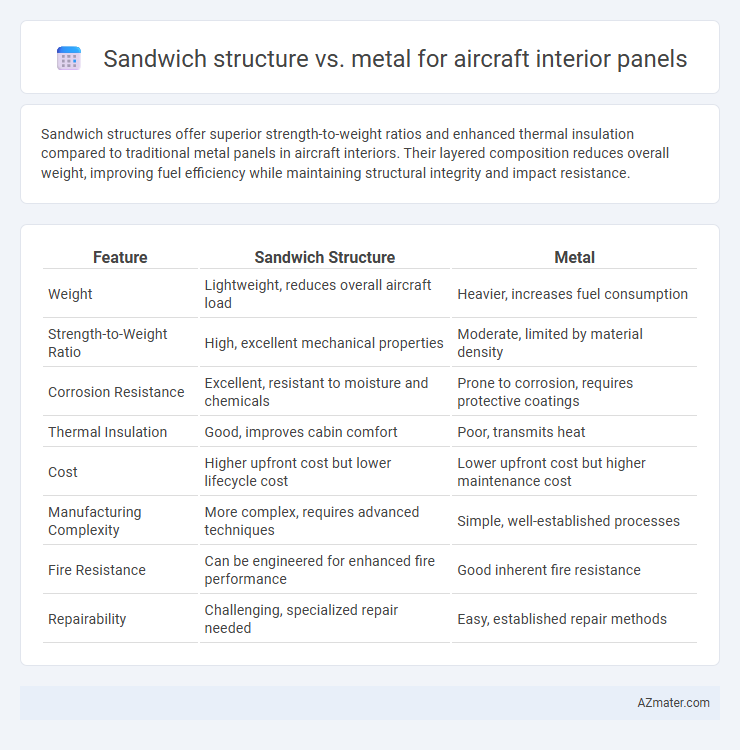Sandwich structures offer superior strength-to-weight ratios and enhanced thermal insulation compared to traditional metal panels in aircraft interiors. Their layered composition reduces overall weight, improving fuel efficiency while maintaining structural integrity and impact resistance.
Table of Comparison
| Feature | Sandwich Structure | Metal |
|---|---|---|
| Weight | Lightweight, reduces overall aircraft load | Heavier, increases fuel consumption |
| Strength-to-Weight Ratio | High, excellent mechanical properties | Moderate, limited by material density |
| Corrosion Resistance | Excellent, resistant to moisture and chemicals | Prone to corrosion, requires protective coatings |
| Thermal Insulation | Good, improves cabin comfort | Poor, transmits heat |
| Cost | Higher upfront cost but lower lifecycle cost | Lower upfront cost but higher maintenance cost |
| Manufacturing Complexity | More complex, requires advanced techniques | Simple, well-established processes |
| Fire Resistance | Can be engineered for enhanced fire performance | Good inherent fire resistance |
| Repairability | Challenging, specialized repair needed | Easy, established repair methods |
Introduction to Aircraft Interior Panel Materials
Aircraft interior panels utilize sandwich structures comprising lightweight cores such as honeycomb or foam, bonded between composite or metal face sheets to achieve high strength-to-weight ratios. Metal panels, traditionally made from aluminum alloys, offer durability and fire resistance but add significant weight compared to sandwich composites. Advances in sandwich structure technology enhance impact resistance and acoustic insulation, making them increasingly preferred for modern aircraft interiors where weight reduction and performance optimization are critical.
Overview of Sandwich Structure Panels
Sandwich structure panels for aircraft interiors combine lightweight core materials such as honeycomb or foam with durable face sheets made from aluminum, carbon fiber, or fiberglass, providing exceptional strength-to-weight ratios. These panels offer enhanced thermal insulation, increased damage tolerance, and superior vibration damping compared to traditional metal panels. Their modular design facilitates easier maintenance and customization, making them a preferred choice for modern aircraft cabin applications.
Properties of Traditional Metal Panels
Traditional metal panels used in aircraft interiors, typically made from aluminum alloys, offer high strength, durability, and excellent resistance to impact and wear. These panels provide effective structural support and are known for their predictable performance under various environmental conditions, including temperature fluctuations and humidity. Despite their robustness, metal panels are relatively heavier compared to sandwich structures, impacting overall aircraft weight and fuel efficiency.
Weight Comparison: Sandwich vs. Metal Panels
Sandwich structure panels significantly reduce weight compared to traditional metal panels in aircraft interiors, often achieving up to 50% weight savings due to their core material design combined with lightweight face sheets. These panels enhance fuel efficiency and payload capacity by minimizing overall aircraft mass without compromising structural integrity. Advanced composite cores combined with aluminum or carbon fiber faces provide superior stiffness-to-weight ratios over metal alone.
Strength and Durability Analysis
Sandwich structures, composed of lightweight core materials such as honeycomb or foam bonded between metal or composite skins, offer superior strength-to-weight ratios compared to traditional metal panels, enhancing aircraft interior performance. Their layered construction provides excellent impact resistance and fatigue durability, reducing maintenance needs and extending service life under cyclic loading conditions. Metals, while inherently strong, often present higher weight penalties and lower resistance to corrosion and abrasion, making sandwich structures a preferred choice for optimizing strength and durability in aircraft interior panels.
Fire Safety and Compliance Considerations
Sandwich structures used in aircraft interior panels offer enhanced fire safety due to their lightweight core materials like honeycomb or foam, which are engineered to meet strict FAA and EASA flammability standards such as FAR 25.853. Metal panels, while inherently non-combustible and excellent for heat resistance, can contribute to higher aircraft weight, potentially impacting fuel efficiency and performance compliance. Compliance considerations emphasize that sandwich structures must pass rigorous fire penetration and smoke toxicity tests to ensure occupant safety without compromising the aircraft's regulatory certification.
Acoustic and Thermal Insulation Performance
Sandwich structures in aircraft interior panels provide superior acoustic insulation by incorporating foam or honeycomb cores that effectively dampen noise compared to solid metal panels. These composite panels also excel in thermal insulation, reducing heat transfer and improving cabin comfort through their low thermal conductivity materials. Metal panels, while durable and lightweight, generally offer lower acoustic and thermal insulation performance due to their higher thermal conductivity and sound transmission properties.
Cost-Efficiency and Lifecycle Economics
Sandwich structures in aircraft interior panels offer significant cost-efficiency through reduced weight, leading to lower fuel consumption and maintenance expenses compared to traditional metal panels. The lifecycle economics favor sandwich composites by minimizing corrosion issues and extending service intervals, which reduces long-term operational costs. Metal panels, while generally cheaper upfront, incur higher maintenance and replacement expenses due to susceptibility to fatigue and corrosion over time.
Installation and Maintenance Differences
Sandwich structures for aircraft interior panels offer easier installation due to lightweight composite cores and pre-bonded layers, reducing assembly time compared to traditional metal panels. Maintenance of sandwich panels typically requires specialized repair techniques for core and skin damage, contrasting with metal panels that can be more straightforwardly inspected and repaired via conventional methods like riveting or patching. The reduced corrosion risk and lower thermal conductivity of sandwich materials also impact long-term maintenance strategies compared to metal alternatives.
Future Trends in Aircraft Interior Panel Materials
Sandwich structures, combining lightweight cores such as honeycomb or foam with composite facesheets, offer superior strength-to-weight ratios, making them a leading choice for future aircraft interior panels focused on weight reduction and fuel efficiency. Advanced materials like carbon fiber reinforced polymers (CFRP) and high-performance thermoplastics are increasingly replacing traditional metals such as aluminum alloys due to their enhanced corrosion resistance and design flexibility. Emerging trends emphasize sustainable, recyclable materials and multifunctional panels integrating sensors or fire-resistant properties to meet evolving regulatory and passenger comfort demands.

Infographic: Sandwich structure vs Metal for Aircraft interior panel
 azmater.com
azmater.com